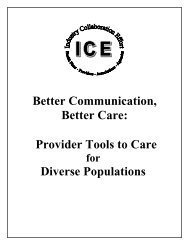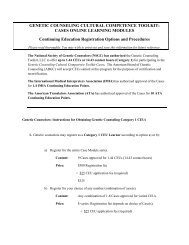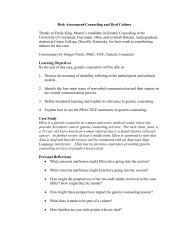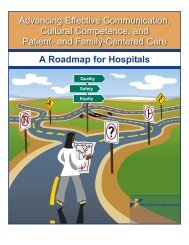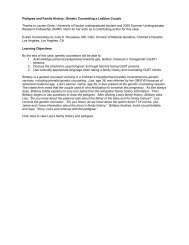making the business case for culturally and linguistically appropriate ...
making the business case for culturally and linguistically appropriate ...
making the business case for culturally and linguistically appropriate ...
You also want an ePaper? Increase the reach of your titles
YUMPU automatically turns print PDFs into web optimized ePapers that Google loves.
specific purpose can result in larger benefits such as increased market share, or expansion ofservices to populations o<strong>the</strong>r than LEP <strong>and</strong> ethnic or cultural minority populations.Work<strong>for</strong>ce <strong>and</strong> bilingual employee development is key. Faced with increasing dem<strong>and</strong> <strong>for</strong>language services, <strong>and</strong> in <strong>the</strong> absence of adequate numbers of on-site qualified health careinterpreters, health care organizations are turning to <strong>the</strong>ir own diverse work <strong>for</strong>ce as a meansto assure <strong>culturally</strong> competent care. Health care organizations serving LEP populations aredeveloping <strong>the</strong>ir work<strong>for</strong>ces by hiring <strong>and</strong> training new <strong>and</strong> existing employees who areei<strong>the</strong>r bilingual or interested in becoming bilingual. Employees proficient in a secondlanguage provide an internal value <strong>and</strong> benefit to a health care organization <strong>and</strong> lead tosavings in annual expenditures <strong>for</strong> outsourced language interpretation services.The projects highlighted in this report show that organizations can save money <strong>and</strong> provideeffective <strong>culturally</strong> competent care by improving <strong>the</strong> language skills of bilingual staff whoserve as interpreters. Most organizations will not have <strong>the</strong> resources to pursue instant across<strong>the</strong>-boardbilingual or bicultural competency. However, organizations successful inimplementing bilingual programming have focused first on those employees who come indirect contact with LEP populations. In addition, cultural competency <strong>and</strong> languageinterpretation training are becoming increasingly available through academic institutions,with provider specific continuing medical education credits granted at program completion.Exploration <strong>and</strong> integration of community partnerships <strong>and</strong> resources is important. CLASSt<strong>and</strong>ard 12 speaks to using community relationships <strong>and</strong> <strong>business</strong> partnerships in health careto reach patients <strong>and</strong> consumers. The Young Children’s Health Center <strong>and</strong> KaiserPermanente used <strong>the</strong>ir local universities <strong>and</strong> colleges to train, educate <strong>and</strong> develop <strong>the</strong>language skills of <strong>the</strong>ir employees <strong>and</strong> staff to serve LEP patients. Contra Costa established apartnership with three regional hospitals to purchase low cost language interpretationservices <strong>and</strong> telephone rates; <strong>and</strong> L.A. Care, with <strong>the</strong> help of local bilingual providers,developed vital translated medial documents in ten languages.Technology can be useful in serving LEP populations. Language interpretation lines <strong>and</strong>satellite technology can help eliminate patient-provider language barriers. With <strong>the</strong> increaseduse of cell phones, telephone dual head/h<strong>and</strong>sets <strong>and</strong> satellite voice speaker phones, healthcare organizations can operate <strong>and</strong> update communication technology to eliminate <strong>the</strong>barriers <strong>and</strong> challenges related to accessing in-person language interpretation when needed.Per<strong>for</strong>mance measurement should be a component of <strong>the</strong> CLAS project plan. Health careorganizations that want to begin <strong>and</strong> continue CLAS interventions must take <strong>the</strong> necessarysteps to identify track <strong>and</strong> document <strong>the</strong> qualitative <strong>and</strong> quantitative outcomes of CLASprojects. In addition, those working on CLAS interventions must work as a team withfinancial staff members, <strong>and</strong> solicit in<strong>for</strong>mation from non-programmatic managers <strong>and</strong> staffto support <strong>the</strong> continuation of <strong>the</strong>ir programs.Many CLAS resources are already available. Organizations may benefit from <strong>case</strong> examplesprovided in this report as well as pre-existing materials on CLAS. (Resources are identifiedin Appendix P.) The Agency <strong>for</strong> Healthcare Research <strong>and</strong> Quality, <strong>and</strong> <strong>the</strong> Center <strong>for</strong>Medicare <strong>and</strong> Medicaid Services (CMS) published a particularly helpful guide <strong>for</strong> managedcare plans interested in implementing CLAS initiatives. The guide includes in<strong>for</strong>mation onhow to conduct an organizational assessment <strong>for</strong> CLAS, create a planning team, assess <strong>the</strong>26


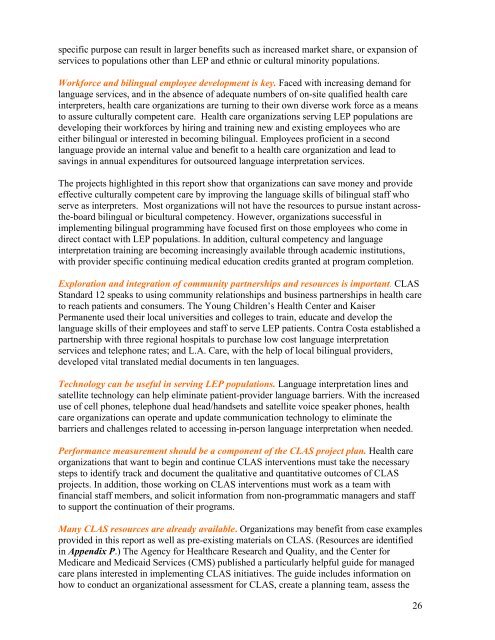

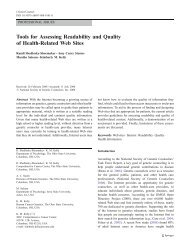

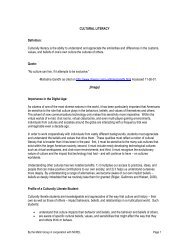
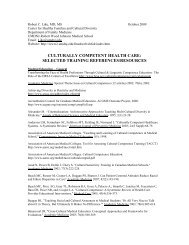

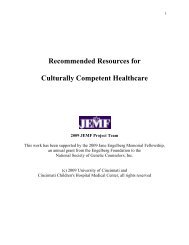
![Breaking Bad News PPT[1] - Genetic Counseling Cultural ...](https://img.yumpu.com/35003134/1/190x146/breaking-bad-news-ppt1-genetic-counseling-cultural-.jpg?quality=85)
